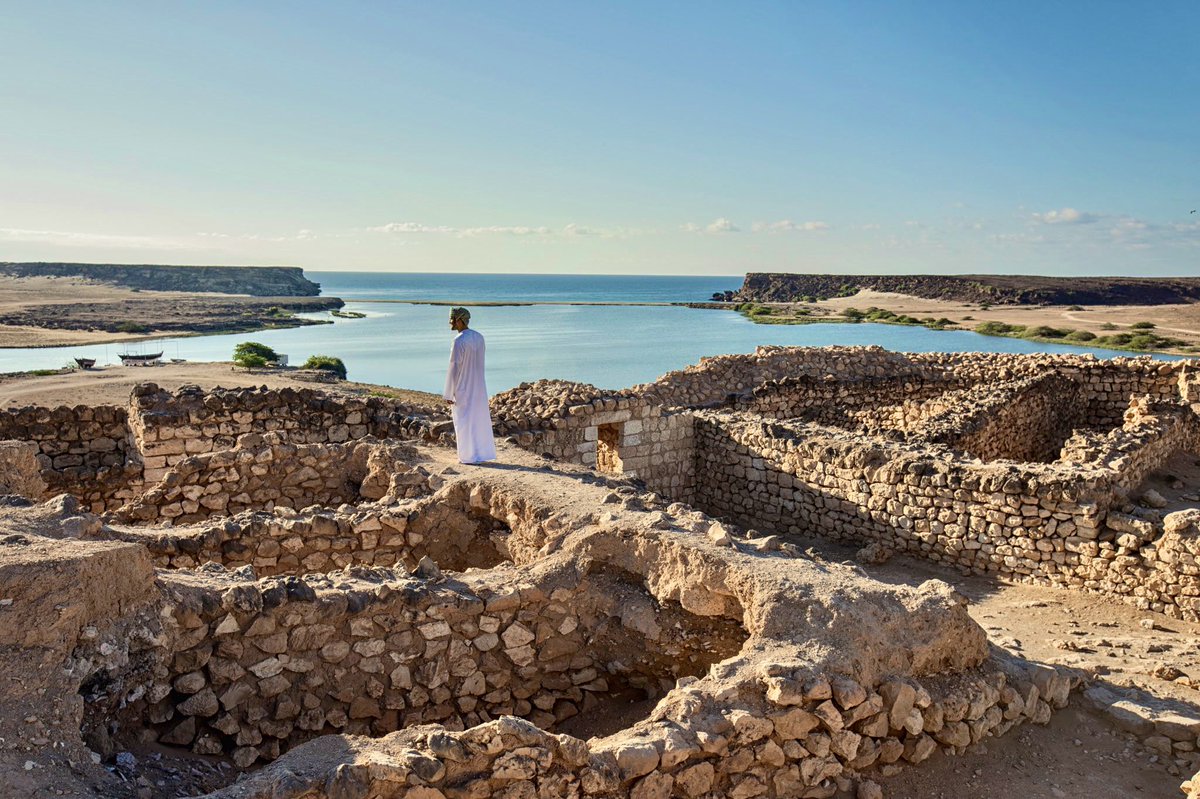Frankincense, woodsy & sweetly aromatic, is one of the oldest commodities spanning more than 6,000 years. It was once prized more than gold! Frankincense is an integral part of Oman’s culture & heritage, its trade flourishing for centuries.
A thread on the frankincense of Oman…
A thread on the frankincense of Oman…

1/ Used for millennia as a perfume & panacea, frankincense (from the Old French ‘franc encens’ meaning pure incense) is an aromatic resin harvested from trees of the rugged Boswellia genus, which grows exclusively in a narrow climate belt from the Horn of Africa to India & China 

2/ In ancient times the Frankincense Trail was considered to be the most important commercial route throughout southern Arabia. The incense land trade from South Arabia to the Mediterranean flourished roughly between 7 BC till approximately 2 AD. 

3/ The Frankincense Trail served as a channel for the trading of goods such as: Arabian frankincense & myrrh; Indian spices, precious stones, pearls, ebony, silk & fine textiles; and East African rare woods & gold. Oman was a hive of activity and a hub of unseen opulence. 

4/ The incense trade played a key role in the early history of the Arabian Peninsula — bringing immense wealth to Omani ports and cities and also permitting cultural exchange between diverse civilisations 

5/ Today, most of the world’s supply of frankincense comes from Somalia, Eritrea and Yemen. However, Oman produces the world’s finest – and most expensive – frankincense, a substance that was revered by the ancient Egyptians 

6/ The mystical, woodsy & sweetly aromatic rich scent of frankincense (known locally as luban) is unavoidable in Oman. This is especially true in the city of Salalah in the southernmost governorate of Dhofar, where frankincense trees grow wild. 

7/ The hardy Boswellia sacra tree thrives in the inhospitable terrain of Oman’s southern province of Dhofar. The value of frankincense resin is determined by its colour, clump size and oil concentration.
8/ The most valuable grade of frankincense known as hojari, comes from a narrow, dry microclimate belt of the Dhofar Mountains just beyond reach of the summer monsoon that blankets the tip of the Arabian Peninsula in mist. 

9/ Today, the frankincense trees studding this region, and a number of caravan routes and ports dating from the 4th Century BC, are part of Oman’s Unesco-inscribed Land of Frankincense World Heritage site. 

10/ The ruins of Samharam are part of the Land of Frankincense UNESCO World Heritage Site. The port played an important role in trade over 2000 years ago. The city was founded as a main port for Frankincense trade at the end of the first century! 

11/ According to Unesco’s description, “the trade in frankincense that flourished in this region for many centuries [was] one of the most important trading activities of the ancient and medieval world.” 

12/ From Oman, caravans with thousands of camels laden with frankincense set off on a daunting 2,000km-long overland journey across the Arabian Desert – destined for the Egyptian, Babylonian, Greek and Roman Empires – while ships laden with the resin travelled as far as China.
13/ In ancient times the Frankincense Trail was considered to be the most important commercial route throughout southern Arabia. From Moscha frankincense was shipped overland across Oman’s rugged interior to the ancient capital of Hadhramaut and beyond into Egypt. 

14/ Roman polymath Pliny the Elder (23-79AD) wrote that the trade had made the southern Arabians “the richest people on Earth”. 

15/ The aspirin & penicillin of its day, frankincense was considered an effective remedy for everything from haemorrhoids to menstrual pains and melanoma. Greek military physician Pedanius Dioscorides described frankincense as a cure-all wonder drug 

16/ The best quality of frankincense is found in the Dhofar region of Oman & is abundantly available in the souqs. Hafa Souq in Salalah is an exclusive place that sells them. Oman’s frankincense trail in Dhofar region was visited by explorers Marco Polo and Lawrence of Arabia. 

17/ Frankincense tree in a wadi in Dhofar Southern Oman : frankincense gum oozing from stripped bark 

18/ Also called the perfume capital of Arabia, Salalah is home to the most valued species of frankincense trees in the world, Boswellia sacra, from which sap is sourced and dried to become little crystals of frankincense resin - once worth more than gold
19/ According to Oman’s Ministry of Tourism, “Frankincense is a symbol of life, or rather it is life itself, for the Dhofari people. It is not a mere tree, but an embodiment of culture, history, sociology and geography” 

20/ The Omani researcher and historian, Abdul Qadir bin Salim Al Ghassani, mentions in his book ‘Dhofar, the Land of Frankincense’ that Alexander the Great had imported huge quantities of incense from Arab lands. 

22/ Historically, people chew frankincense like gum to treat digestive ailments. It was also consumed to boost the immune system. Frankincense is edible both in the hardened state and the oil. The edible varieties are translucent in colour, with no dark-colored impurities 

23/ The smoke from burning Frankincense drives away insects. Due to its proven antiseptic and anti-inflammatory properties, frankincense was used in salves for wounds and sores, for indigestion & chronic coughs. Frankincense is said to be uplifting & calming to the nervous system 

24/ Still used in important ceremonies including religious festivals, frankincense also remains a symbol of Omani hospitality. Its fragrant resin is sill burned today throughout the Sultanate to welcome guests. 

• • •
Missing some Tweet in this thread? You can try to
force a refresh























